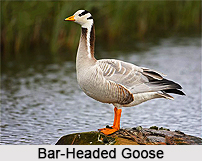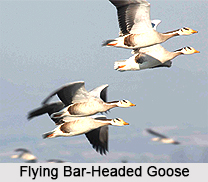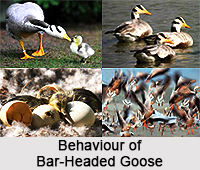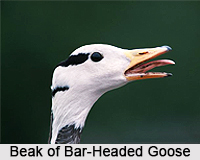 Bar-headed goose, an Indian bird with a scientific name "Anser indicus" is a goose that breeds in Central Asia in colonies of thousands near mountain lakes and winters in South Asia, as far south as peninsular India. It lays three to eight eggs at a time in a ground nest.
Bar-headed goose, an Indian bird with a scientific name "Anser indicus" is a goose that breeds in Central Asia in colonies of thousands near mountain lakes and winters in South Asia, as far south as peninsular India. It lays three to eight eggs at a time in a ground nest.
Concentration of Bar-Headed Goose
Bar-headed goose has sometimes been separated from Anser, which has no member indigenous to the Indian region not any at all to the Ethiopian, Australian, or Neotropical regions and placed in the monotypic genus Eulabeia.
Structure of Bar-Headed Goose
Bar-headed goose is pale grey and is easily distinguished from any of the other grey geese of the genus Anser by the black bars on its head. It is also much paler than the other geese in this genus. In flight, its call is a typical goose honking. A mid-sized goose measures 71-76 cm (28-30 in) in total length and weighs 1.87-3.2 kilograms.

Supplies of Oxygen by Bar-Headed Goose
The main physiological challenge of bar-headed geese is extracting oxygen from hypoxic air and transporting it to aerobic muscle fibres in order to sustain flight at high altitudes. Flight is very metabolically costly at high-altitudes because birds need to flap harder in thin air to generate lift. The haemoglobin of their blood has a higher affinity for oxygen compared to low-altitude geese, which has been attributed to a single amino acid point mutation. This mutation of Bar-headed goose causes a conformational shift in the haemoglobin molecule from the low oxygen affinity form to the high oxygen affinity form. The left-ventricle of Bar-headed goose of the heart, which is responsible for pumping oxygenated blood to the body via systemic circulation, has significantly more capillaries in bar-headed geese compared with lowland birds, maintaining oxygenation of cardiac muscle cells and thereby cardiac output. Compared to lowland birds, mitochondria in the flight muscle of bar-headed geese are significantly closer to the sarcolemma, decreasing the intracellular diffusion distance of oxygen from the capillaries to the mitochondria of Bar-headed goose.
 Residence of Bar-Headed Goose
Residence of Bar-Headed Goose
The summer habitat of Bar-headed goose is high-altitude lakes where the bird grazes on short grass. The species has been reported as migrating south from Tibet, Kazakhstan, Mongolia and Russia before crossing the Himalaya.
Bar-Headed Goose as the World highest Flying Bird
Bar-headed goose is one of the world`s highest-flying birds, having been heard flying across Mount Makalu - the fifth highest mountain on earth at 8,481 meters and apparently seen over Mount Everest 8,848 m.
Migration of Bar-Headed Goose
 Bar-headed goose is moving towards north migrating from lowland India to breed in the summer on the Tibetan Plateau that is undertaken in stages, with the flight across the Himalaya (from sea-level) being undertaken non-stop in as little as seven hours. Surprisingly, despite predictable tail winds that blow up the Himalayas (in the same direction of travel as the geese), bar-headed geese spurn these winds, waiting for them to die down overnight, when they then undertake the greatest rates of climbing flight ever recorded for a bird, and sustain these climbs rates for hours on end. Bar-headed goose migrates over the Himalayas to spend the winter in parts of South Asia (from Assam to as far south as Tamil Nadu). The modern winter habitat of the species is cultivated fields, where it feeds on barley, rice and wheat, and may damage crops. Birds from Kyrgyzstan have been noted to stopover in western Tibet and southern Tajikistan for 20 to 30 days before migrating further south. Some birds may show high wintering site fidelity.
Bar-headed goose is moving towards north migrating from lowland India to breed in the summer on the Tibetan Plateau that is undertaken in stages, with the flight across the Himalaya (from sea-level) being undertaken non-stop in as little as seven hours. Surprisingly, despite predictable tail winds that blow up the Himalayas (in the same direction of travel as the geese), bar-headed geese spurn these winds, waiting for them to die down overnight, when they then undertake the greatest rates of climbing flight ever recorded for a bird, and sustain these climbs rates for hours on end. Bar-headed goose migrates over the Himalayas to spend the winter in parts of South Asia (from Assam to as far south as Tamil Nadu). The modern winter habitat of the species is cultivated fields, where it feeds on barley, rice and wheat, and may damage crops. Birds from Kyrgyzstan have been noted to stopover in western Tibet and southern Tajikistan for 20 to 30 days before migrating further south. Some birds may show high wintering site fidelity.
Nestlings of Bar-Headed Goose
Bar-headed goose nest mainly on the Tibetan Plateau. Intra-specific brood parasitism is noticed with lower rank females attempting to lay their eggs in the nests of higher ranking females. The bar-headed goose is often kept in captivity, as it is considered beautiful and breeds readily.



















